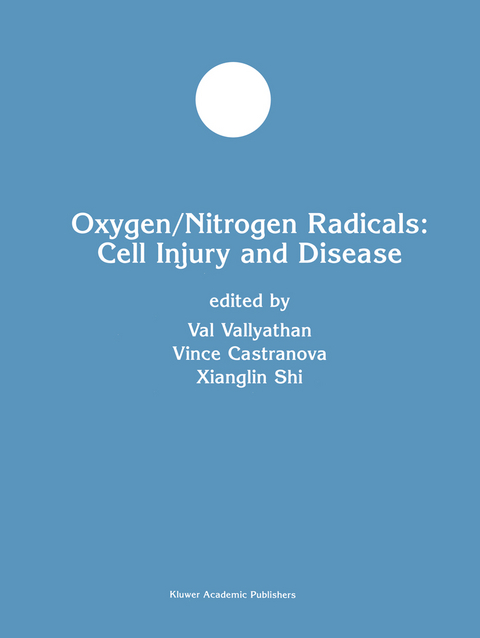
Oxygen/Nitrogen Radicals: Cell Injury and Disease
Springer-Verlag New York Inc.
978-1-4613-5388-1 (ISBN)
Cyclic oxidation and reduction of protein methionine residues is an important antioxidant mechanism.- Signal transduction by nitric oxide in cellular stress responses.- Effects of antioxidants against atherosclerosis.- Molecular pathology of dityrosine cross-links in proteins: Structural and functional analysis of four proteins.- The role of nitric oxide in lung innate immunity: Modulation by surfactant protein-A.- Redox signaling.- Control of mitochondrial membrane potential and ROS formation by reversible phosphorylation of cytochrome c oxidase.- Molecular mechanisms of nitrogen dioxide induced epithelial injury in the lung.- Differential role of hydrogen peroxide in UV-induced signal transduction.- Upregulation of phosphoinositide 3-kinase and protein kinase B in alveolar macrophages following ozone inhalation. Role of NF-KB and STAT-1 in ozone-induced nitric oxide production and toxicity.- Phospholipase D/phosphatidic acid signal transduction: Role and physiological significance in lung.- Role of mitogen-activated protein kinases (MAPK) in cell injury and proliferation by environmental particulates.- Doxorubicin-induced apoptosis: Implications in cardiotoxicity.- Depletion of Bcl-2 by an antisense oligonucleotide induces apoptosis accompanied by oxidation and externalization of phosphatidylserine in NCI-H226 lung carcinoma cells.- Interactions of copper with glycated proteins: Possible involvement in the etiology of diabetic neuropathy.- Mechanisms of neutrophil-induced DNA damage in respiratory tract epithelial cells.- Asbestos-induced alveolar epithelial cell apoptosis: Role of mitochondrial dysfunction caused by iron-derived free radicals.- Involvement of hydrogen peroxide in asbestos-induced NFAT activation.- NF-KB, a pivotal transcription factor in silica-induced diseases.- Effect of inhaled crystalline silica in a rat model: Time course of pulmonary reactions.- The role of AP-1, NF-KB and ROS/NOS in skin carcinogenesis: The JB6 model is predictive.- Reactive oxygen species in choline deficiency induced carcinogenesis and nitrone inhibition.- Tumor necrosis factor-a gene promoter polymorphism in coal workers’ pneumoconiosis.- Nitric oxide decreases the sensitivity of pulmonary endothelial cells to LPS-induced apoptosis in a zinc-dependent fashion.- Cytokine polymorphisms in silicosis and other pneumoconioses.- Endogenous regulation of the acute inflammatory response.- Role of nitric oxide in liver ischemia and reperfusion injury.- Oxidative stress and TNF-a induce histone acetylation and NF-KB/AP-1 activation in alveolar epithelial cells: Potential mechanism in gene transcription in lung inflammation.- Heme oxygenase/carbon monoxide signaling pathways: Regulation and functional significance.- The role of oxidative stress in nickel and chromate genotoxicity.- Arsenic carcinogenicity: Relevance of c-Src activation.- Roles of ferritin and iron in ischemic preconditioning of the heart.- Molecular mechanisms of Cr(VI)-induced carcinogenesis.- Arsenic induces oxidative DNA damage in mammalian cells.- Generation of reactive oxygen species in the enzymatic reduction of PbCrO4 and related DNA damage.- Soluble metals as well as the insoluble particle fraction are involved in cellular DNA damage induced by particulate matter.- Nitroxides as antioxidants: Tempol protects against E09 cytotoxicity.- Reversal of fluoride induced cell injury through elimination of fluoride and consumption of diet rich in essential nutrients and antioxidants.- Measurements in vivo of parameters pertinent to ROS/RNS using EPR spectroscopy.- In vivo imagingof free radicals: Applications from mouse to man.- In vivo bioassays of acute asbestosis and its correlation with ESR spectroscopy and imaging in redox status.- On the application of 4-hydroxybenzoic acid as a trapping agent to study hydroxyl radical generation during cerebral ischemia and reperfusion.- In vivo detection of nitric oxide distribution in mice.- In vivo measurement of tumor redox environment using EPR spectroscopy.- Index to volume 234/235.- Instructions to Authors.
| Reihe/Serie | Developments in Molecular and Cellular Biochemistry ; 37 |
|---|---|
| Zusatzinfo | VIII, 406 p. |
| Verlagsort | New York, NY |
| Sprache | englisch |
| Maße | 210 x 279 mm |
| Themenwelt | Medizin / Pharmazie ► Medizinische Fachgebiete ► Pharmakologie / Pharmakotherapie |
| Naturwissenschaften ► Biologie ► Biochemie | |
| ISBN-10 | 1-4613-5388-2 / 1461353882 |
| ISBN-13 | 978-1-4613-5388-1 / 9781461353881 |
| Zustand | Neuware |
| Haben Sie eine Frage zum Produkt? |
aus dem Bereich


